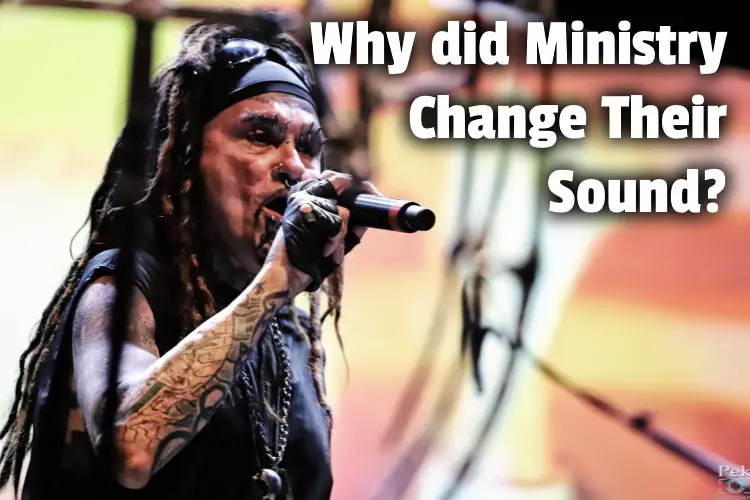
Ministry originally started as a synth-pop group only to evolve as one of the pioneering industrial metal bands in the early 1990s. But why did Ministry change their sound?
Here’s what I’ve seen over the years:
Ministry changed their sound in 1986 after founder Al Jourgensen discovered the Belgian record label Play It Again Sam and bands such as Front 242. They used synthesizers too, but in a darker, more alternative way. Then he began to add heavy guitar riffs into the music after hearing bands like KMFDM, which formed in 1984.
But with the addition of metal guitarist Mike Scaccia, of the band Rigor Mortis, in 1989, they evolved to create what became Ministry’s signature sound.
That being said, it’s worth pointing out that Scaccia didn’t join until after the 4th album, The Mind is a Terrible Thing to Taste, was released. Jourgensen played all the guitars on that album and it does have a lot of heavy riffs on songs such as “Burning Inside”.
Of course, if you hear Jourgensen in interviews, he claims that Ministry’s first album, With Sympathy, was basically forced on him by the record label.
Jourgensen spoke to Chicago Tribune, describing his experience about working with Arista Records during their first studio album “With Sympathy” as “trying to write with a gun to your head.”
However, Jourgensen stated in 2019 that the record was ‘fine’. Although, the band could have been better without the interference from the record company.
But which of these versions are true?
How did the band’s new sound come to be? Was Ministry able to put the lid on their dodgy synth-pop past while rising as a metal band? Let us find answers to all these questions!
Was Ministry really a synth-pop group originally?
Ministry was once labeled as “synth-pop.” And for the first 5 years of their existence, their sound was closer to that of Depeche Mode. But the group eventually discarded this style in favor of a darker more industrial style. But through 1988, they were still primarily synth-based.
Ministry emerged when British synth-pop was taking the music industry by storm.
Hence, Ministry’s early albums even go so far as for Jourgensen (who is Cuban by birth) to adopt a British accent. And the Chicago-based group led by Al Jourgensen would have done anything to make it in the business.
They adopted the British synth-pop and put out a larger-than-life-onstage persona. Their first studio album (With Sympathy, 1983) was full of British-inflected, slick synth-pop combining synthesizers and guitar.
Danceable grooves, as heard in the track “I Wanted to Tell Her,” and the dark-disco track “Work for Love” boast gothic-tinted electro inspirations.
However, a short time after the release of this album, Al took a 180-degree turn towards the genre.
The band began showing its fondness for more industrial drum machine rhythms (thanks in part to the departure of founding drummer Stephen George) and sampled sound effects hanging at the fence between synth-pop and aggressive industrial.
Over the years, the band’s reputation hasn’t faded. They led the wave of synth-pop, industrial, and eventually metal, efficiently, if I am not exaggerating some of these points slightly.
MINISTRY – TWITCH #industrial #synthpop #usa 35 YEARS pic.twitter.com/XWoKN3M65O
— Helel (@tropicalcrust) March 12, 2021
When did the Ministry start sounding industrial?
Ministry started sounding industrial with the release of their second studio album, Twitch in 1986. That album moves toward darker, aggressive, and more abrasive sounds heavily influenced by industrial dance groups such as Front 242. But that album was still mostly synth-based.
Musically, the band’s second studio album was beat-driven and stepped away from synth pop-oriented form. It largely incorporated the growing elements of industrial scenes of the mid-1980s.
Many authors described Twitch’s overall sound as reminiscent of Ministry’s contemporaries such as Front 242, The Cure, and Cabaret Voltaire.
The album combined electronica, industrial, and EBM/industrial dance records. The album also contained material ascribed to two latter genres and Dance-pop, Eurodisco, Synth-pop.
Released worldwide, the music critic Robert Christgau described Twitch as:
“fleetingly gothic and marginally industrial, stepping into a murky swamp that distorted Jourgensen’s nearly spoken vocals within a pounding electronic rhythm onslaught”
Although the album received mixed reviews, it clearly displayed Ministry’s tone was heading towards Industrial.
I was lucky enough to see Ministry on the Twitch tour (the 1st of a few times), and it was a great show with Paul Baker on bass and a special appearance by Luc Van Acker for the encore of the Revolting Cocks songs, “Attack Ships on Fire” and “No Devotion”.
Check out the setlist of the show I saw here – https://www.setlist.fm/setlist/ministry/1987/cave-club-austin-tx-33dbd429.html
Born on this day in 1958, Al Jourgensen of @WeAreMinistry turns 63. I think I’ll listen to “With Sympathy” and “Twitch” today in his honor. pic.twitter.com/zAXzzomgAB
— JΞFF Ҝ (@jeffknet) October 9, 2021
Why does Al Jourgensen not like With Sympathy?
Al Jourgensen began to later slam the With Sympathy album after Ministry had changed their sound, and he was concerned his new, more metal-oriented fans, would not understand it. So he went to great lengths to distance himself from it, sometimes with complete fabrication.
And although Jourgensen has slammed the album on many occasions calling it “abortion of an album”, he admits that With Sympathy paved his way to musical success.
Jourgensen spoke to The Quietus to join a discussion on abandoning his first album. This is what Al told the magazine:
“It was revolting, disgusting, and it traumatized me for years. I was sick to my stomach daily. I threw up more on that record. It was absolutely an abortion period of my life. I hated myself, the world, and everything around me because of that record.”
Reportedly, this 1st album resulted from the record label’s desire to create a more diluted and palatable pop sound.
And although Jourgensen has claimed that his original sound was forced on him by his former label, there are plenty of live YouTube videos that predate his record deal that prove that those songs and their sound were indeed exactly what he wanted at the time.
In addition to this, Jourgensen says that without “With Sympathy,” he wouldn’t be who he became. And he thinks that he wouldn’t be a “maniac douchebag” so, he’s thankful for the album.
Industrial metal band Ministry performing tonight in Pharr.http://t.co/gblwYVKKGQ#RGV pic.twitter.com/KP5f7B8jsy
— The Monitor (@monitornews) June 5, 2015
Why did Ministry become a metal band?
Ministry became a metal band as it was a natural evolution of their increasingly heavy sound following 1988’s The Land of Rape and Honey. Then with the addition of metal guitarist Mike Scaccia from the thrash band Rigor Mortis in late 1989, they were able to fully transform into an industrial metal band.
When a reader, Simon Parrock, asked Al Jourgensen, ‘What made you change from synth to rock?’, Jourgensen replied:
“We basically never changed; that was a record label decision…. they just assigned us producers and backing musicians- they even wrote lyrics for me. They had me cut my hair, bought me a wardrobe because they wanted me to be wham! I didn’t sign up for that shit!”
Jourgensen continued:
“It’s not like we changed from synth to rock- that’s the contract we were under, and as soon as we were out of it, we became Ministry. That was a rude awakening to the perils of the music industry.”
However, this was a story that Al made up and he later denounced these statements in his biography.
As I mentioned, when Jourgensen wanted a more metal-based fan base, he felt obligated to fabricate a story about his early synth leanings so he could more easily claim that wasn’t really who he was.
But make no mistake. Ministry started as a synthpop band because that’s what Al liked at the time.
Listen to this Album by the Industrial Metal Band, Ministry pic.twitter.com/MQTo2W27hs
— ☃️Mountain Man Billy❄️ (@TW1N_66RZ) February 13, 2021
Was Ministry more popular as a synth band or an industrial metal band?
Ministry is more popular as an industrial-metal band than a synth band. With Sympathy charted at #96 and no song on it has more than 1.4 million streams on Spotify. Many of their industrial metal songs have tens of millions of streams, and they had 2 of those albums in the Top 40.
Compared to Ministry’s synth-pop era, the band gained more commercial success by exploring the industrial genre.
For example, while the band’s debut LP, a synth-pop-oriented album, received mixed reviews, Ministry’s third album, The Land of Rape and Honey, became Gold-certified by RIAA in January 1996.
It became the blueprint for all what was to be tagged as “industrial dance music”- Tom Moon.
Ministry attained more success with albums like The Mind Is a Terrible Thing to Taste (1989) and Psalm 69 (1992). All these albums marked the band’s stylistic departure from synth-pop.
Today, the band has become a legendary name in the music world. From grabbing a spot in Billboard’s 200 highest chart position makers to becoming a 6-time Grammy Award nominee, the band’s breakthrough commercial success as an industrial band is unsurpassable.
But let’s look specifically at some of Ministry’s best-known songs and how many streams they have on Spotify as of the time of this writing:
| Song Title | Musical Genre | # Streams on Spotify |
| Jesus Built My Hotrod | Industrial | 14,301,000 |
| Just One Fix | Industrial Metal | 9,600,000 |
| N.W.O. | Industrial | 7,200,000 |
| Effigy (I’m Not An) | Synth-Pop | 1,400,000 |
| Revenge | Synth Pop | 1,600,000 |
| Everyday is Halloween | Synth-Pop | 5,900,000 |
| Over the Shoulder | Industrial Synth | 338,000 |
One such example of a band from the era that comes to my mind that significantly evolved their sound throughout their band’s journey and made it a success is The Cure.
Because The Cure’s technique involved combining elements from Emo and Goth, both genres, fans often found themselves divided in opinion to label the band either as a Goth or Emo.
Luckily, I made sure to discuss that detail in a recent article to help you find the difference between the two.
Just click that link to read it on my site.
Conclusion
Ministry is one of the acts that has gone through most stylistic evolutions. They are one of the best-loved industrial bands. However, hardcore fans know that Ministry wasn’t always a metal band.
The group started as a synth-pop group- an image that Jourgensen claimed overtime imposed on them by their record label then.
However, the band was able to walk past their dodgy-synth past and later morphed into their well-famous heavier, sample riddled sound that got Ministry their tag- Industrial metal.
That being said, in 2021, Ministry’s official Instagram page featured a guitar lesson on how to play the song Effigy (I’m Not An) from the With Sympathy album. So that’s hardly something they would do if they truly saw that album as a pariah.
Unlike many bands that fail to evolve in the genre-crossing, Ministry remains an unforgettable name that successfully stood the test of time.
Photo which requires attribution:
Ministry by Bruno is licensed under CC2.0 and was cropped, edited, and had a text overlay added.
